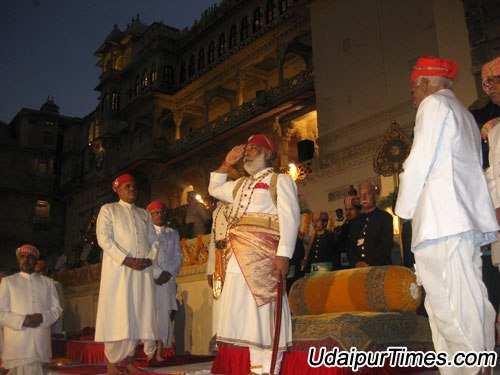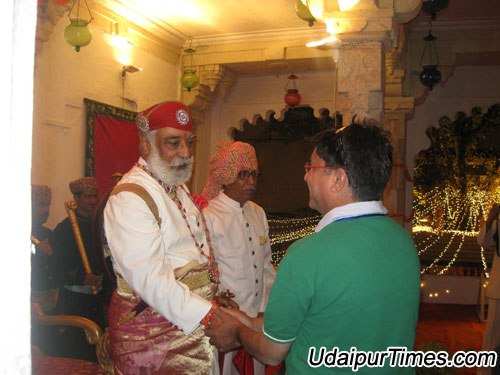Ashwa Poojan: The Regal Festival Of Worshipping The Horse
According to Hindu traditions, a horse has very important religious significance; they are the symbol of loyalty, self-respect, and power. At the time of wars they not only become warrior’s lone supporters bu
According to Hindu traditions, a horse has very important religious significance; they are the symbol of loyalty, self-respect, and power. At the time of wars they not only become warrior’s lone supporters but also sometimes are the only scope and hope for survival. This day acts as a medium to show our gratitude and honor towards the noble breed of horses to which we owe so much. Shastra (arms which were used during war) are also worshipped on this day.
Continuing this old tradition, Shakti Parva, a grand Regal Festival was celebrated at Manak Chowk, City Palace Complex, Udaipur, today, October 16, 2010 at 5:30pm. Ashawa Poojan (horse worship ceremony) and Shastra Poojan (arms worship ceremony) were performed by the present Maharana of the royal family, Shreeji Arvind Singh Ji Mewar. This event is organized every year on Navami (ninth day) of Navratra.
Significance of the day (navami):
Navratri is one of the most auspicious times in the Hindu Calendar. The festival of Navratri, lasting for nine days and nights and hence known as Navrarti, is dedicated to the worship in Hindu mythology of the goddess Durga, the consort of Shiva. Ma Durga (Mother) representing Shakti (Power) is depicted in nine popular avtars (forms) on each of the nine different days during the month of Ashwin (September/October).
The ninth day of Navratri is called Ram-Navami, the culminating day of the nine-day festival. Commemorating the bond, the interdependence and the partnership of horse and Rajput for centuries, Ashwa Poojan is really the grand finale to the Navratri festvities, invoking both, the power of Durga and Ashwa.
The Royal Horses:
The horses participating in the poojan belong to an internationally recognized breed known as “Marwari”. This name is reflective of their area of origin, which is now a part of the present state of Rajasthan. Te art of selection or choosing the horse is exceedingly complex and is described in books known as the “Salotar”. The royal horses selected for the poojan – Raj Tilak, Raj Roop, Ganesh, Raj Swaroop and Tarangini have been bred on the guidelines provided in these salotars.
Significance of Ashwa Poojan:
As a part of Living Heritage, the celebration of Ashwa Poojan is testimony to the traditional reverntial acknowledgement of the empathy between a Rajput and his Horse, continued since the ancient time, practiced and followed till this day. The House of Mewar salutes this legendary association by perpetuating the tradition of worshipping the horse, attempts to preserve the intangible cultural heritag of Eternal Mewar.
Ashwa Poojan 2010:
The highlight of the Regal Festival of Ashwa Poojan is indeed the regal procession, where Shriji Arvind Singh Mewar, the 76th Custodian House of Mewar arrived in a 1905 vinatge ‘English Royal Landau Six-in-Hand’, purchased from Dykes and Co., Calcutta in the reign of Maharana Fateh Singh (r. 1884-1930).
During the Ashwa Poojan Ceremony, the Palace Band was positioned in front of the stage where Five Royal Horses – Raj Tilak, Raj Roop, Ashwaraj, Raj Swaroop and Tarangini were traditionally worshipped by the Custodian of the House of Mewar.
Shriji Arvind Singh Mewar conducted the prayer ceremony and observed the rites and rituals as guided by the priests of the Palace.
……….
The Royal Insignia of the State of Mewar are only used when the Custodian himself is present. In the procession the following insignia were included:
There were two Chadiwalas carrying the long gold staff, two Gotawalas carrying the short gold batons symbolizing the authority of the State. Two men carried the Fly-Whisk and were positioned at the back of the horse drawn carriage, 1905 vintage ‘Royal Landau Six-in-Hand’. At the stage, where the 76th Custodian House of Mewar was seated to conduct the Ashwa Poojan ceremony, there were two men wearing Chapdas i.e. Coat of Arms of the House of Mewar on their sashes, two carried peacock feathers or Mor Chal, one each carried Adani, Chaagir, and Meghadumber. There were also two men carrying Karaniya with the Sun emblem and one carried the Chattra or the large umbrella.
The sacred ceremony was followed by the Nazraana – a traditional ceremony involving the noblemen of Udaipur; and also, guests meeting the 76th Custodian House of Mewar. The evening’s celebration continued at the Ganesh Chowk where sumptuous refreshments were organized by HRH Group of Hotels.
……….
Ashwa Poojan is one of the Regal Festivals performed every year at The City Palace Complex, upholding age-old traditions of the House of Mewar, the world’s largest-serving dynasty. The festival is a manifestation of ‘Eternal Mewar’ for visitors who come from far and near to witness this historic spectacle.
This celebration was witnessed by many dignitaries and tourists from various parts of the world.
Here are some memorable moments of Ashwa Poojan 2010, captured by Sayeed Ahmed of UT Team.
VIDEOS
PHOTOS
History & Information Courtsey: Ashwa Poojan Information Booklet by MMCF.
To join us on Facebook Click Here and Subscribe to UdaipurTimes Broadcast channels on GoogleNews | Telegram | Signal

























